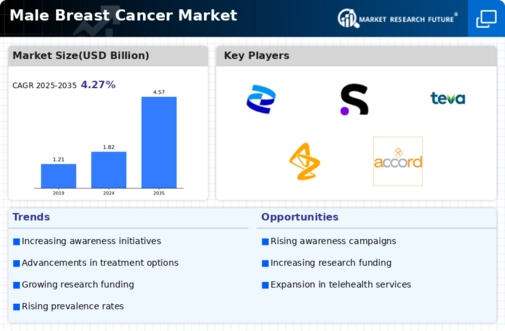Rising Incidence Rates
The Male Breast Cancer Market is witnessing a notable increase in incidence rates, which appears to be driven by a combination of genetic predispositions and environmental factors. Recent data indicates that the incidence of male breast cancer has been rising, with estimates suggesting that approximately 2,650 new cases are diagnosed annually. This increase in cases necessitates enhanced awareness and treatment options, thereby propelling the Male Breast Cancer Market forward. As more men are diagnosed, the demand for specialized healthcare services, including screening and treatment, is likely to grow. This trend may also lead to increased funding for research and development, further stimulating the market.
Growing Support Networks
The establishment of support networks and advocacy groups is playing a pivotal role in the Male Breast Cancer Market. These organizations are dedicated to raising awareness, providing resources, and offering emotional support to men diagnosed with breast cancer. The presence of such networks not only helps in disseminating information about the disease but also encourages men to seek timely medical attention. As these support systems expand, they are likely to foster a more informed patient population, which may lead to increased screening and treatment uptake, thereby positively influencing the Male Breast Cancer Market.
Increased Research Funding
The Male Breast Cancer Market is experiencing a surge in research funding, which is essential for advancing treatment options and understanding the disease better. Government and private organizations are increasingly recognizing the need for focused research on male breast cancer, leading to a rise in grants and financial support for clinical trials. This influx of funding is likely to accelerate the development of innovative therapies and improve patient outcomes. As research progresses, new treatment modalities may emerge, further enhancing the Male Breast Cancer Market and providing hope for affected individuals.
Evolving Treatment Paradigms
The Male Breast Cancer Market is undergoing a transformation due to evolving treatment paradigms. Traditional treatment options, such as surgery and radiation, are being complemented by targeted therapies and immunotherapy, which show promise in improving patient outcomes. The introduction of personalized medicine, tailored to the genetic profile of the tumor, is likely to enhance treatment efficacy. As more treatment options become available, the Male Breast Cancer Market is expected to expand, catering to a diverse range of patient needs and preferences. This evolution in treatment approaches may also lead to increased collaboration among healthcare providers, researchers, and pharmaceutical companies.
Improved Diagnostic Techniques
Advancements in diagnostic techniques are significantly impacting the Male Breast Cancer Market. Enhanced imaging technologies, such as digital mammography and MRI, are becoming more accessible, allowing for earlier detection of male breast cancer. Early diagnosis is crucial, as it can lead to better treatment outcomes and survival rates. The market is likely to benefit from the integration of these advanced diagnostic tools into routine healthcare practices. Furthermore, the development of genetic testing for BRCA mutations in men is expected to increase awareness and facilitate early intervention, thereby driving growth in the Male Breast Cancer Market.

















Leave a Comment